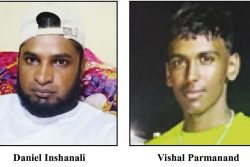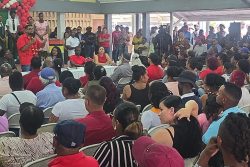Had the public security situation throughout the country not been so dreadful, the public might not have realised just how much time the Minister of Home Affairs spends on issues which have little to do with everyday violent crimes. Mr Rohee seems attached to day-trips along the coastland at the head of little groups of members of the National Commission on Law and Order. But with what result?
When he visited Crabwood Creek and other surrounding villages on the Corentyne Coast last June, residents raised matters that seemed relatively light. According to the Government Information Agency, issues included the proliferation of petty crimes, requests for firearm licences, encumbrances on the public road and Government reserves, drug trafficking, the noise nuisance, youth gangs, irresponsible garbage disposal and slothful response by the police.
Mr Rohee, later in June, visited residents of Tuschen, East Bank Essequibo to address the security issues affecting them and to provide suggestions and solutions. Some of the issues that were raised included the large number of stray animals on the public road, the noise nuisance and small robberies around the Tuschen market.
Earlier this month, July, the ministerial roadshow reached the Essequibo Coast and the near-hinterland communities of Wakapau, Akawini and Friendship on the Pomeroon River. GINA wearily pointed out that most of the issues raised – the noise nuisance, stray animals on the public road, acquisition of firearm licences, use of illicit drugs, youth gangs, violence against women, irresponsible garbage disposal, issuance of birth certificates, land titling and more effective policing – were similar to those which had already been raised at the Minister’s encounters with residents of the Essequibo Islands-West Demerara, Demerara-Mahaica and East Berbice-Corentyne Regions.
While the Minister has been reaching out to listen to lighter side of crime, serious crimes were occurring uninterrupted throughout the country. In the hinterland, for example, miners were murdered at Echerak and Issano. There were murders also of a woman on the Georgetown seawall; a watchman in Sophia; a wedding guest at Friendship in the Pomeroon and another abused wife at Port Mourant. There were also two cases of suspected arson – at Parfait-Harmonie and at Sophia.
These murders point to two policing deficiencies. First is the lawless conditions in the ‘bush’ where, owing partly to inadequate police presence, too many personal disputes are settled violently resulting in death. Second is the ineffectual nature of the distorted form of community policing preferred by the Ministry. The evidence suggests that a more relevant form of police-community relations could have identified the threat to the victims of murder and arson and protected them from their identifiable assailants.
Fatal road accidents continued apace, particularly at night on the notorious unlit speedways. The scenes of accidents in July – at No.12 Village and Woodley Park on the West Coast Berbice; at Le Resouvenir on the East Coast and at Land of Canaan on the East Bank, Demerara – tell a story of reckless driving and lax law-enforcement. The Minister rarely comments on the crime of piracy about which little has been done throughout his nearly four years at the Ministry. There was yet another piracy attack off the shore at Whim on the Corentyne earlier this month. More attacks can be expected because nothing is being done to stop them.
The Minister’s meet-the-people tours to talk about the lighter side of crime might be entertaining. Public security could be better served, however, if he ventured to the scenes of the really serious crimes and if he expended his energies on equipping the Guyana Police Force to make our communities safer.
.








